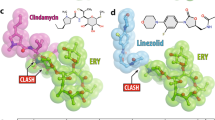Abstract
Macrolides have been used in the treatment of infectious diseases since the late 1950s. Since that time, a finding of antagonistic action between erythromycin and spiramycin in clinical isolates1 led to evidence of the biochemical mechanism and to the current understanding of inducible or constitutive resistance to macrolides mediated by erm genes containing, respectively, the functional regulation mechanism or constitutively mutated regulatory region. These resistant mechanisms to macrolides are recognized in clinically isolated bacteria. (1) A methylase encoded by the erm gene can transform an adenine residue at 2058 (Escherichia coli equivalent) position of 23S rRNA into an 6 N, 6 N-dimethyladenine. Position 2058 is known to reside either in peptidyltransferase or in the vicinity of the enzyme region of domain V. Dimethylation renders the ribosome resistant to macrolides (MLS). Moreover, another finding adduced as evidence is that a mutation in the domain plays an important role in MLS resistance: one of several mutations (transition and transversion) such as A2058G, A2058C or U, and A2059G, is usually associated with MLS resistance in a few genera of bacteria. (2) M (macrolide antibiotics)- and MS (macrolide and streptogramin type B antibiotics)- or PMS (partial macrolide and streptogramin type B antibiotics)-phenotype resistant bacteria cause decreased accumulation of macrolides, occasionally including streptogramin type B antibiotics. The decreased accumulation, probably via enhanced efflux, is usually inferred from two findings: (i) the extent of the accumulated drug in a resistant cell increases as much as that in a susceptible cell in the presence of an uncoupling agent such as carbonylcyanide-m-chlorophenylhydrazone (CCCP), 2,4-dinitrophenol (DNP), and arsenate; (ii) transporter proteins, in M-type resistants, have mutual similarity to the 12-transmembrane domain present in efflux protein driven by proton-motive force, and in MS- or PMS-type resistants, transporter proteins have mutual homology to one or two ATP-binding segments in efflux protein driven by ATP. (3) Two major macrolide mechanisms based on antibiotic inactivation are dealt with here: degradation due to hydrolysis of the macrolide lactone ring by an esterase encoded by the ere gene; and modification due to macrolide phosphorylation and lincosamide nucleotidylation mediated by the mph and lin genes, respectively. But enzymatic mechanisms that hydrolyze or modify macrolide and lincosamide antibiotics appear to be relatively rare in clinically isolated bacteria at present. (4) Important developments in macrolide antibiotics are briefly featured. On the basis of information obtained from extensive references and studies of resistance mechanisms to macrolide antibiotics, the mode of action of the drugs, as effectors, and a hypothetical explanation of the regulation of the mechanism with regard to induction of macrolide resistance are discussed.
Similar content being viewed by others
Author information
Authors and Affiliations
Additional information
Received: February 15, 1999 / Accepted: February 25, 1999
About this article
Cite this article
Nakajima, Y. Mechanisms of bacterial resistance to macrolide antibiotics. J Infect Chemother 5, 61–74 (1999). https://doi.org/10.1007/s101560050011
Issue Date:
DOI: https://doi.org/10.1007/s101560050011



